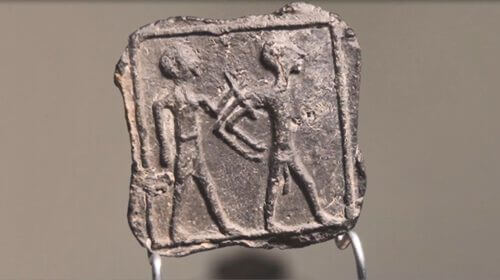6-year-old Imri Elia from Kibbutz Nirim in the Gaza Strip, went out last March with his parents for a walk at the archaeological site Tel Jama, which is located near Kibbutz Ra'im, in the northern Negev. Suddenly, a small square object made of clay, measuring 2.80 x 2.80 cm, caught his eye. The curious boy picked up the object, and to his surprise he saw two figures on it. Imri's parents contacted the Antiquities Authority and handed the item over to the state treasures

6-year-old Imri Elia from Kibbutz Nirim in the Gaza Strip, went out last March with his parents for a walk at the archaeological site Tel Jama, which is located near Kibbutz Ra'im, in the northern Negev. Suddenly, a small square object made of clay, measuring 2.80 x 2.80 cm, caught his eye. The curious boy picked up the object, and to his surprise he saw two figures on it. Imri's parents contacted the Antiquities Authority and handed the item over to the state treasures.
After photographing and documenting the object in the digital photography laboratories of the Antiquities Authority, the archaeologists were surprised to discover that it was a special and rare find, the likes of which have almost never been discovered in archaeological excavations in Israel.
From research conducted by archaeologists Sa'ar Ganor, Itamar Weissbein and Oren Shmueli from the Antiquities Authority, it appears that the object was embedded in a carved pattern, and the artist's fingerprints even survived on its back. On top of the plate, which seems to have been placed in a larger object, is depicted a scene of a man leading a captive. The figure of the captive, wearing a skirt, holds a captive naked as on the day he was born, his hands folded and tied behind his back. It is evident that the artist wanted to emphasize the humiliation the captive goes through by being led naked, and perhaps even depict an ethnic difference between the figure of the captive and the figure of the captive, by presenting different facial features for each of the figures; While the captive's hair is curly and his face is full, the captive is thin and his face is elongated.
According to the researchers, "it seems that the craftsman who created the plate was influenced by similar representations known from the art of the ancient Near East. The technique of binding the captive's hands is known from reliefs and objects found in Egypt and North Sinai." Although the tablet was not found as part of an organized archaeological excavation, the researchers estimate, based on the parallels with the Egyptian art world and the local Canaanite art, that the object should be dated to the Late Bronze Age (between the 12th and 15th centuries BC).
The violent description evident on the object raises interesting questions regarding the historical background against which the plate was made. During this period, the Egyptian Empire ruled the land of Canaan. This was divided into "city-states" ruled by local kings.
From letters sent by the kings of Canaan to Egypt at the time (known as the letters to Amarna), it is known that there were internal struggles and conflicts of control between the Canaanite cities.
In the archaeological research, Tel Jama is identified with the Canaanite city of Jurza - one of the strongest Canaanite cities in the south of the country. Researchers Ganor, Weisbein and Shmuel from the Antiquities Authority estimate that the scene depicted on the plaque symbolically represents the power struggle between the city of Yurza and one of the cities near the site - possibly Gaza, Ashkelon or Lakish, or a struggle with a nomadic population that lived in the Negev. According to them, "The scene depicted on the plaque is taken from descriptions of victory processions, so the plaque should be seen as a story showing the power of the ruler over his enemies. It seems that the new find opens a visual window to understanding the struggles for control in the south of Israel during the Canaanite period."
According to Pablo Betzer, archaeologist for the southern region of the Antiquities Authority, "Antiquities are the cultural heritage of all of us, and each find adds a piece to the complete puzzle, which is the story of the land. There is great importance in delivering archaeological finds to the state treasures, so that they can be researched and presented, for the enjoyment of the entire public. The handing over of the plate to the Antiquities Authority testifies to the moral education and good citizenship of Imri and his parents. Well done!"
More of the topic in Hayadan:
